So you just delivered your baby and you want to know when you can train abs again?
In this post you will learn:
- How soon you can train abs postpartum
- What ab exercises are safe to do after pregnancy
- A simple postpartum ab workout you can use to strengthen your core
Keep reading to learn more.
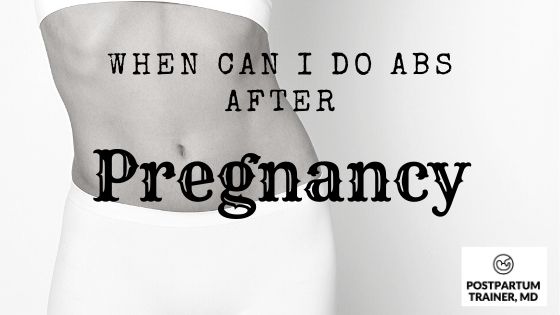
Is It OK / Safe To Do Ab Workouts Postpartum?
Yes, it is safe to do ab workouts after pregnancy. However, it is important that you take your time and listen to your body.
You can’t just jump right into a traditional core routine. You should always start with basic core exercises that teach you how to activate your transverse abdominis muscles.
When can I Start To do ab exercises postpartum?
In general, you can start doing gentle core and pelvic floor exercises a few days after delivery.
You should NOT do traditional ab exercises such as sit-ups or leg raises until you have been evaluated and cleared by a healthcare provider.
How Soon Can You do Crunches after having a baby?
You should be able to do sit-ups and crunches 6-12 weeks after a vaginal delivery and at least 12 weeks after a c-section.
However, doing sit-ups and crunches might not be the best for you, right away, especially if you have diastasis recti.
Many experts argue that sit-ups are an exercise you should avoid in the postpartum.
Let’s go over the best exercises you can do after having a baby.
What Kind Of Ab Exercises Can I Do Soon After Delivery?
So if you can’t do crunches, what should you do instead? You can begin with some basic core stabilization exercises.
Instead of doing exercises where your core is moving, you should do exercises where your core is stable.
That is the whole basis of static core training.
That’s not to say that you aren’t moving. In some of these exercises, your pelvis or your extremities will move, while your core stays stable.
When doing each one of these exercises, you should focus on keeping your ab muscles tight and engaged.
That is how you activate the corset muscle- the transverse abdominis.
For the first 2-4 weeks postpartum, I want you to do posterior pelvic tilts and diaphragmatic breathing.
Posterior Pelvic Tilts
The posterior pelvic tilt is a very simple exercise that you can do while lying down.
Lie on the floor with your knees bent and feet flat. All you have to do is concentrate on bringing your belly button down towards the floor by flattening out the curve in your lower back.
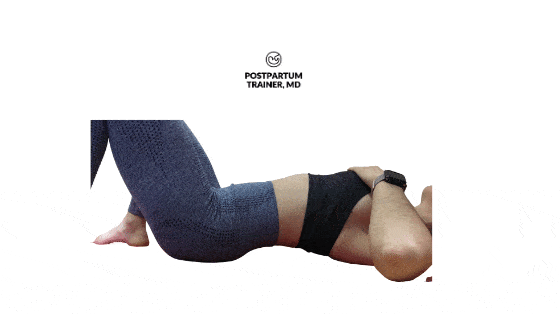
This will naturally shift your pelvis back and activate your deep core muscles. Hold this position for a 3-count and release.
If this exercise causes you pain or discomfort – do not do it!
Diaphragmatic Breathing
Diaphragmatic breathing is another simple exercise you can do immediately after your delivery. This exercise will help improve oxygenation while strengthening your core and pelvic floor muscles.
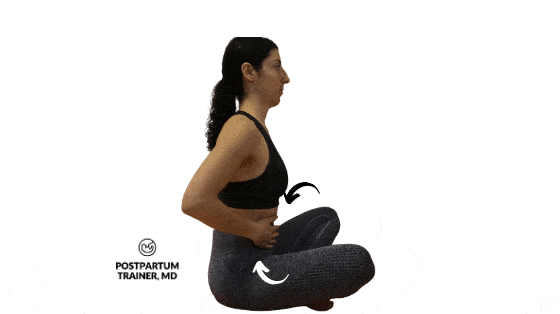
You can do this exercise while lying down or sitting up. To start, take a deep breath by expanding your belly outward and to the sides much as you can.
Try your best to not breathe into your chest (i.e, don’t shrug up). After you inhale, hold your breath for a 3 count, and then exhale slowly and completely.
By exhaling as much as you can, your core muscles will be activated.
If this exercise causes you pain or discomfort – do not do it!
As time goes on, you’ll be able to do more and more core exercises. Your healthcare provider can give you more guidance as to what you can and cannot do.
Pelvic Floor Exercises
During this time, I also want you to focus on training your pelvic floor.
The best exercise to strengthen these muscles is the Kegel exercise.
I have created an entire post that goes over the best exercises to strengthen your pelvic floor after delivery.
4 Gentle Core Exercises You Can Do Postpartum
Once you have gotten the hang of activating your transverse abdominis muscle, you can do more complex exercises.
How soon will you be able to do these? I can’t say for certain, however, you may be able to start doing these exercises 6-12 weeks after a vaginal delivery, or 12-16 weeks after a c-section.
It all depends on how you heal.
But before you start, make sure that your doctor says it is safe for you to do them.
As soon as you have clearance, and you feel ready for ab workouts, here’s how to get started.
*Two more caveats*
If you have diastasis recti, you might benefit from doing a diastasis recti-specific program. You can check out my diastasis recti ab exercises here.
Secondly, if any of these exercises cause you pain or discomfort, DO NOT DO THEM* Go see your doctor to determine if you need further evaluation by a physical therapist!
Otherwise, let’s get started.
The Modified Plank
The plank is one of the best static core exercises you can do.
Traditionally, you do this exercise on the floor. Either on your elbows or on your hands like a push-up position.
In the postpartum period, the plank may be too difficult or place too much pressure on your abs.
Here are a few ways you can modify it.
The first way is to just do the planks on an elevated surface.
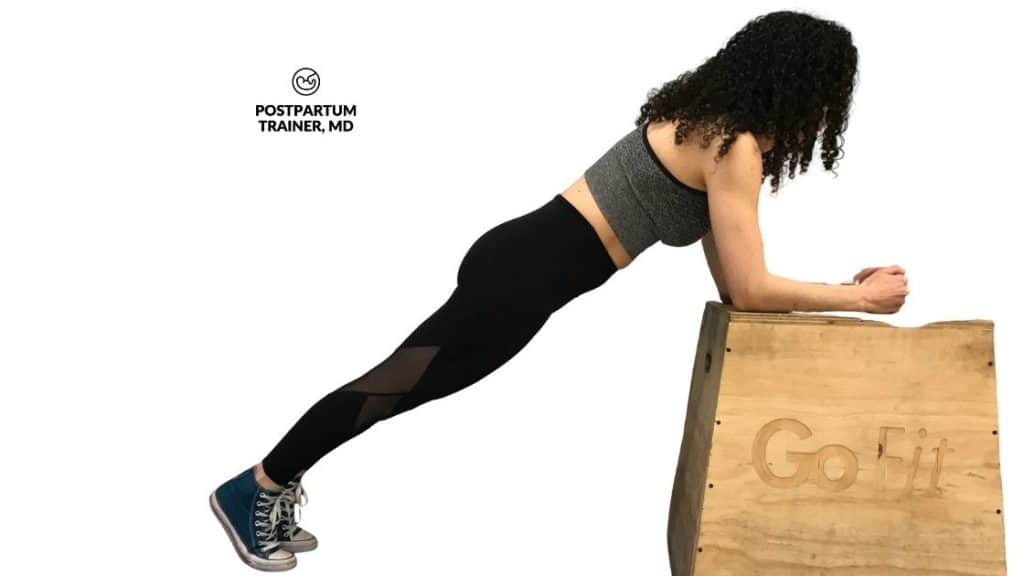
This could be on a table or even on your kitchen sink.
The second way to modify the plank is to simply bend one knee and let it rest on the floor. You then keep the other leg extended.
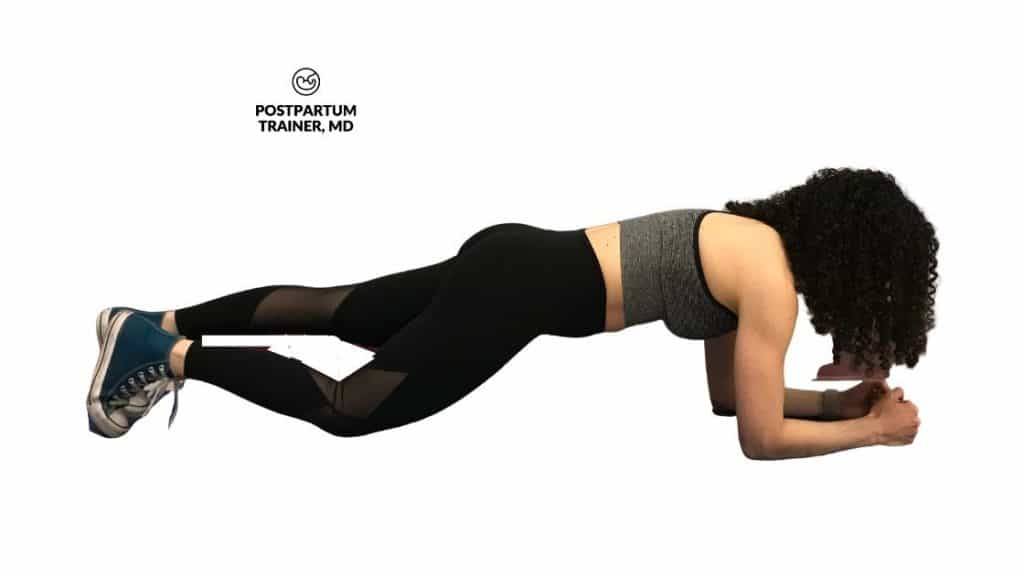
As you are doing this exercise, try to create a semi-hollow back position. It is also important that you keep the ab muscles really tight and engaged as you are doing the exercise.
Hold the plank position for 15-30 seconds.
Bird Dogs
The next core exercise you can do postpartum is the bird dog. To do it properly, you need to start on your hands and your knees or the table top position.
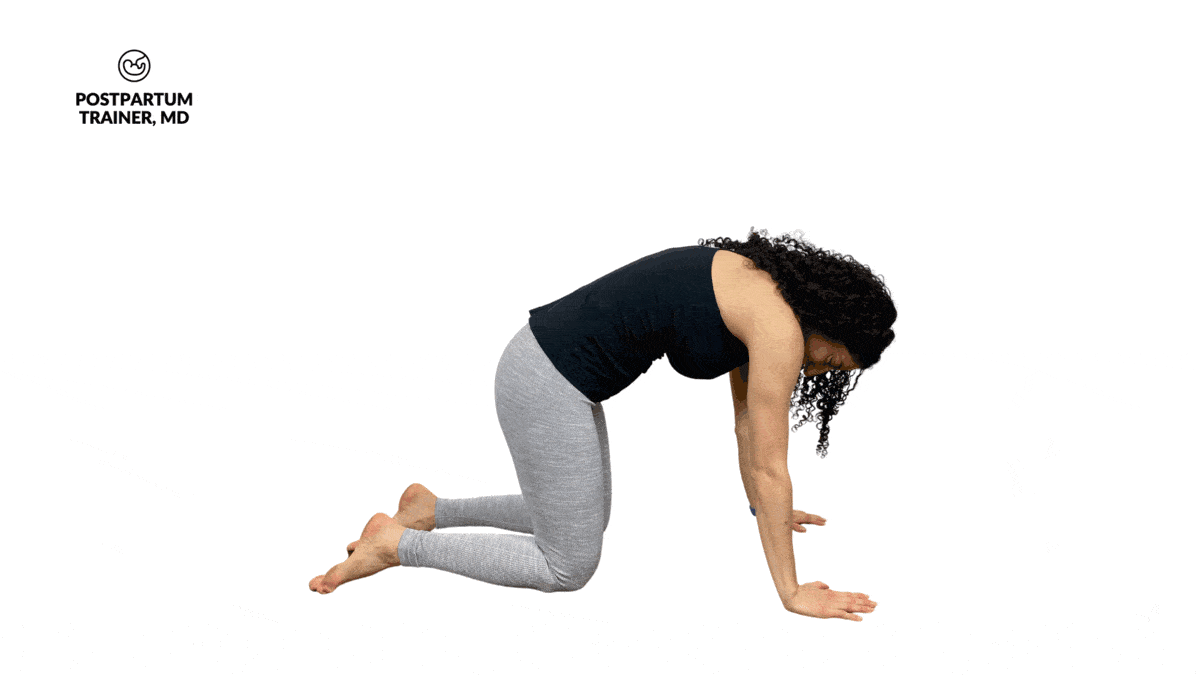
Keep your back straight, and your head looking down at the ground. Next, straighten one arm directly in front of you while straightening your opposite leg behind you.
Go through the motion slowly and engage your ab muscles.
Hold the top position for 3-5 seconds and slowly return back to the starting position.
Aim for 4-6 repetitions on each side.
The Dead Bug
The dead bug is very similar to the bird dog. Instead of doing the exercise on your hands and knees, you will do it on your back.
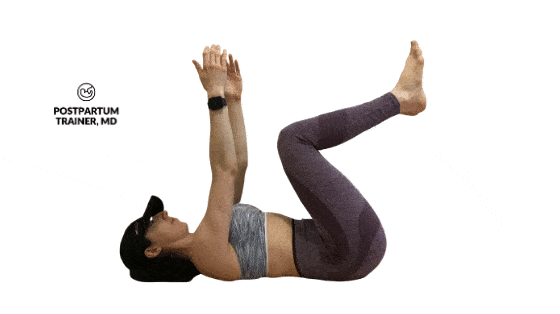
While lying on your back, bend your knees up toward your chest and straighten your arms up toward the ceiling.
Then, perform a posterior pelvic tilt to flatten your low back and create a neutral spine.
Next, you are going to bring one of your arms up above your head while straightening out the opposite leg towards the floor.
Don’t let your heel touch the floor.
Hold that position for 3-5 seconds and return back to the starting position.
Aim for 4-6 repetitions on each side.
Lying Knee Drops
The last core exercise you can do postpartum to help strengthen your abs is the lying knee drop.
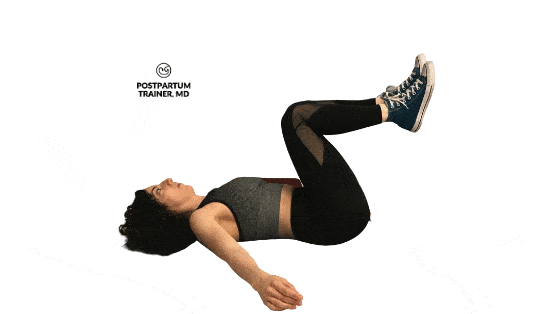
To do this exercise, lie on your back and bend your knees up towards your chest.
Then, perform a posterior pelvic tilt to flatten your low back against the floor. Hold this position throughout the exercise.
Next, slowly straighten out one leg towards the ground without letting your heel touch the floor.
Slowly bring that leg back to the starting position, and then repeat on the next side.
To make this movement easier, you can keep your heels on the floor and slide them down until your leg is straight.
Aim for 4-6 repetitions on each side.
A Safe Postpartum Ab Workout For New Moms
As with all workouts, you do not need to do them every day to see results.
Here is the postpartum ab workout you can follow as long as you are 6 weeks since your delivery and have had clearance from your provider.
Workout 1
| Exercise | Sets | Repetitions |
|---|---|---|
| Posterior Pelvic Tilts | 1-4 | 4-6 |
| Diaphragmatic Breathing | 1-4 | 4-6 |
| Modified Plank | 1-4 | 15-30 sec |
| Dead Bug | 4-6 per side |
Workout 2
| Exercise | Sets | Repetitions |
|---|---|---|
| Posterior Pelvic Tilts | 1-4 | 4-6 |
| Diaphragmatic Breathing | 1-4 | 4-6 |
| Bird Dogs | 1-4 | 4-6 per side |
| Lying Knee Drops | 1-4 | 4-6 per side |
Start by doing 1 set of all four exercises for one week.
If that goes well, and you aren’t in any pain or discomfort, add a second set of all four exercises the following week.
Gradually increase the number of sets you do on a weekly basis until you can do 3-4 sets of each exercise.
Similarly, once you can do 3-4 sets per exercise, add an additional repetition or second to each movement.
What ab exercises Should You avoid postpartum?
In general, you should avoid any ab exercise that places a lot of outward pressure on your abdominal wall, or involves a lot of bending or twisting.
These include:
- Sit-ups
- Russian twists
- Full planks
- Oblique side bends
Instead, you should focus on strengthening the obliques and transverse abdominis with stabilization exercises.
Let’s go over the anatomy of these muscles in more detail.
What are the 3 Ab Muscles (Basic Anatomy)
The abs are composed of 3 main muscle groups.
The first muscle is the rectus abdominis
This is the six-pack muscle that everyone knows and loves. The rectus helps you flex your torso, and stabilize your spine.
As you can see, the muscle is divided into 8 different quadrants, right along the middle. This midline is called the linea alba.
While the rectus abdominis is front and center, there are other muscles that you need to pay attention to as well.
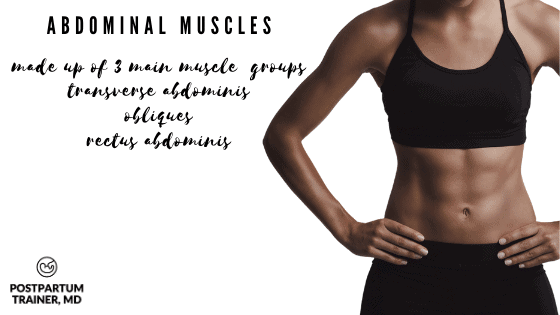
The second muscle are the obliques
These muscles are located on the sides of the rectus.
They are responsible for letting you rotate side to side and bend laterally.
They can also help resist movement in those planes.
The third muscle is the transverse abdominis
This muscle is deeper than the rectus and the obliques. It wraps all the way around your entire abdomen. It’s almost like a corset.
This muscle is responsible for compressing your abdomen. It is this muscle that helps you deliver your child!
So as you can see, your abs, or better yet your core, has many different functions.
What Are The Benefits of Strengthening Your Abs Postpartum?
Even if you never exercised, it’s still a good idea to work out your abs postpartum.
Here are a few more reasons why.
You will be doing a lot of lifting (despite us telling you to avoid any heavy lifting.) Lifting your baby from the floor, from a car seat, or out of a crib.
A strong core can help ensure that your spine stays stable during these movements. This can help prevent muscle strains that lead to low back pain and neck pain.
A strong core postpartum can also help restore your posture. Pregnancy will naturally cause a shift of your pelvis known as anterior pelvic tilt.
By training your abs, you can help realign your pelvis and further reduce your risk of muscle injury and lower back pain.
Lastly, strengthening your core can help improve the changes that happen to your abs during and after pregnancy.
What Happens To Your Abs During Pregnancy?
When you get pregnant, your uterus begins to expand to accommodate your growing fetus.
If you didn’t already know, the uterus is deep to all of your abdominal muscles. So as your uterus gets bigger and bigger, the muscles of your core also have to expand.
Your uterus goes from being the size of a lemon to the size of a watermelon! So as you can see, all three muscle groups will stretch with the growing uterus.
A stretched muscle is a weaker muscle. So that’s why your core gets weak during pregnancy.
In most instances, your rectus abdominis will split right along the linea alba if it is stretched too far.
What Happens To Your Abs After Pregnancy?
After your delivery, what happens to your core muscles? Do they just compress back down to their normal size?
Well, no.
Even though the baby is out, your uterus will still be enlarged. It can take several weeks (6 or more) before it shrinks back down to normal size.
You will begin to start using your core muscles more and more which can help activate and strengthen them. But they will never be as strong as they can be while they are stretched.
This is especially true if you have a significant separation of your rectus muscles along the midline, known as diastasis recti which could occur after a vaginal delivery or cesarean delivery.
This is another reason why you must wait 6 weeks before doing any intense core training.
If you have a large abdominal separation, it is best to not do this postpartum ab workout until you are evaluated by a physical therapist.
Once cleared, you can check out my diastasis recti exercise program.
Here are a few other things you should consider when doing ab exercises after your delivery.
What does diastasis recti feel like?
If you have diastasis recti (DR), you will feel a palpable separation of your abdominal muscles in the midline.
It might feel squishy or flabby inside the separation.
Here is a post on how to tell if you have DR at home.
How Long Does It Take For Abdominal Muscles To Heal After Pregnancy?
It can take anywhere from 6 weeks to 6 months for your abdominal muscles to completely heal after pregnancy.
It depends on the mode of delivery (vaginal vs cesarean), the degree of diastasis recti you may have, and your pre-pregnancy core strength.
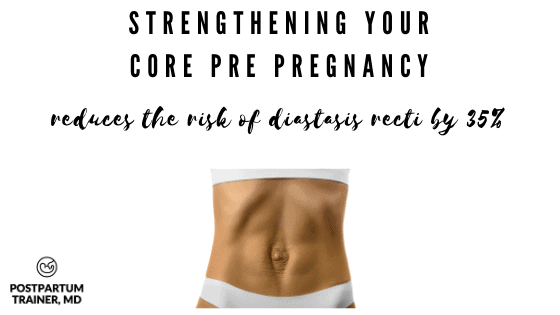
If you maintained an exercise routine while you were pregnant, then your core might heal faster than average.
Nevertheless, I still recommend that you start with diaphragmatic breathing and posterior pelvic tilts in the beginning.
How Can I Tone My Stomach After Having A Baby?
It is important to note that exercise alone will not tone your belly in the postpartum. You must improve your nutrition alongside core training.
Abs aren’t made in the kitchen.
They are made in the gym but revealed in the kitchen. If your diet doesn’t support you in getting lean, you may never have any abs to show for it.

I have written an entire post on how to lose baby fat in the postpartum period.
Final Words On Postpartum Ab Training
Hey momma, I know that you want to get your tummy back to being flat ASAP. But I hope you understand that it is a slow process that you must take one step at a time.
Do your pelvic tilts, deep breathing, and kegels in the early postpartum to prepare for the following weeks.
Only after your doctor has given you clearance should you try these core exercises.
And remember sit-ups and crunches may not be the healthiest exercises to do postpartum.
To learn additional exercises you could perform in the postpartum period, check out my Guide to Getting Fit after Pregnancy.
That’s all for today.
Did you have a lot of ab separation postpartum?
What did you do to improve it?
Comment below and let me know!
Other Articles on Developing Abs Postpartum
- 100 Amazing Exercises to Restore Your Diastasis
- Loose Skin After Pregnancy, What You Need to Know
- How to Get A Flat Stomach After Pregnancy
- How to Get Rid of Your Mommy Pooch
Get Four Free Workouts To Help Strengthen Your Pelvic Floor & Heal Your Mommy Tummy!

Brittany Robles, MD, MPH, CPT
Brittany Robles is a full-time OBGYN physician, a NASM certified trainer, and a prenatal and postnatal fitness specialist. She holds a Master of Public Health degree in maternal health with a special interest in exercise and nutrition. She is also the co-author of The White Coat Trainer. Learn more about her here.
Sharing is Caring – Send This To A Mom In Need!
References:
- Fukano M, Tsukahara Y, Takei S, Nose-Ogura S, Fujii T, Torii S. Recovery of Abdominal Muscle Thickness and Contractile Function in Women after Childbirth. Int J Environ Res Public Health. 2021;18(4):2130. Published 2021 Feb 22. doi:10.3390/ijerph18042130
